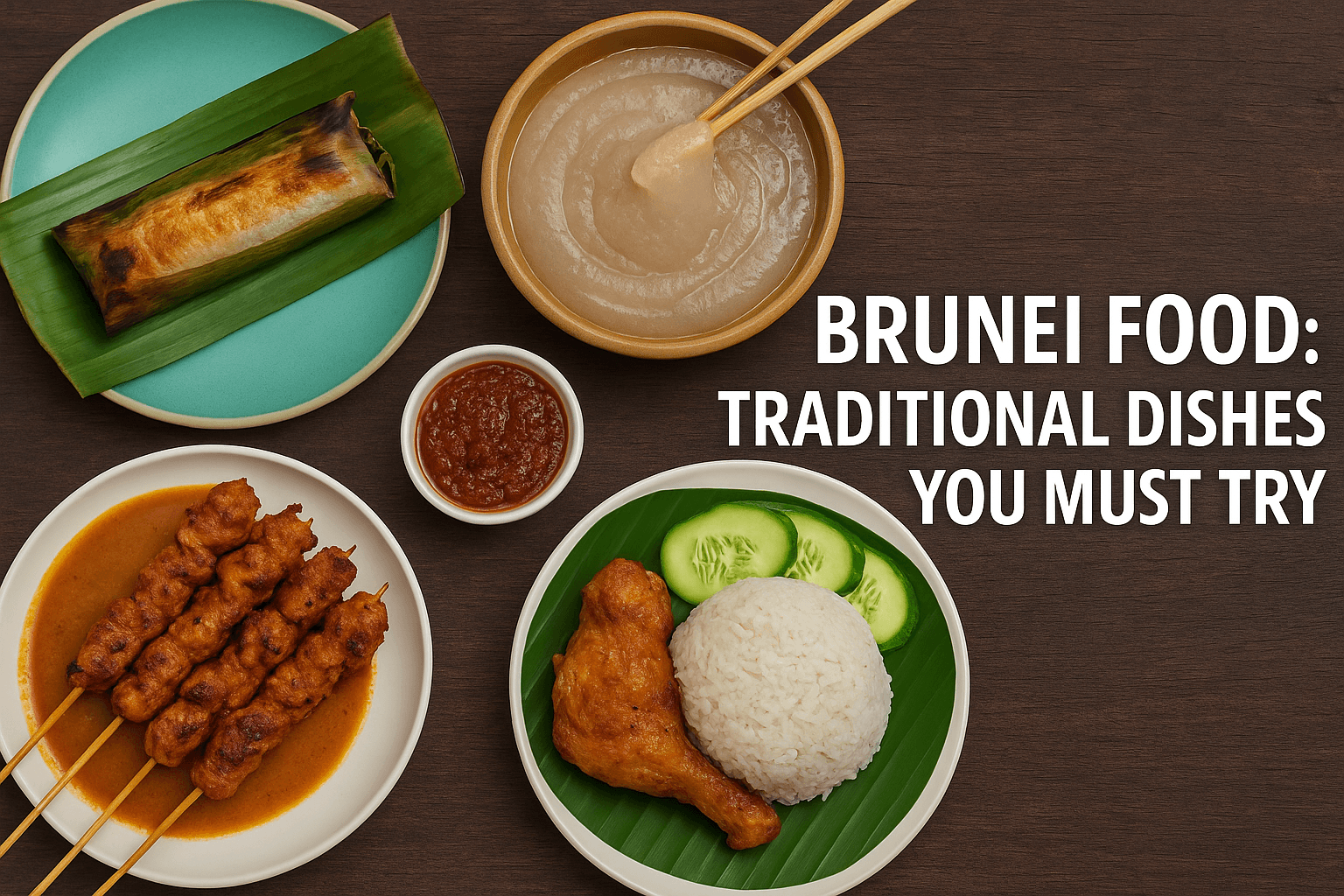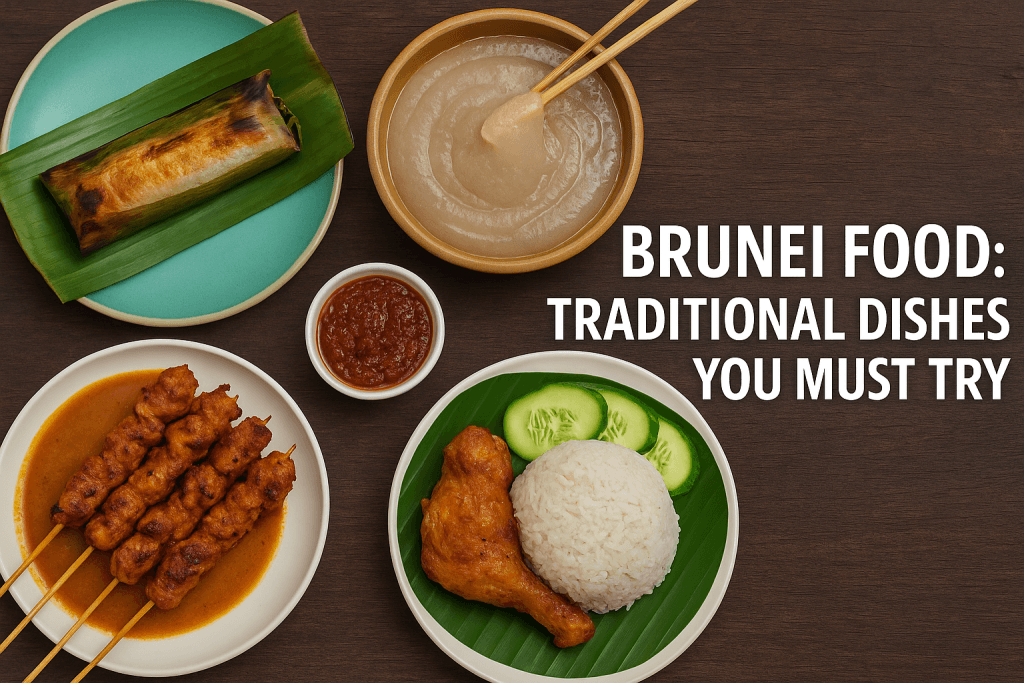Brunei Food: Traditional Dishes You Must Try represents one of Southeast Asia’s most fascinating culinary identities. While Brunei is a small nation on the island of Borneo, its cuisine carries immense cultural depth, combining influences from Malay traditions, Chinese flavors, Indian spices, and the richness of indigenous Bornean food practices. The result is a unique food culture where rice, seafood, and aromatic spices dominate daily meals, while traditional preparation methods and communal dining remain central to society.
Brunei’s food culture is deeply connected to history, geography, and religion. The majority Muslim population ensures that halal food is the standard, shaping how dishes are prepared, served, and consumed. At the same time, the country’s proximity to Malaysia, Indonesia, and the Philippines has infused the cuisine with regional diversity while maintaining authenticity.
Understanding Brunei Food: Traditional Dishes You Must Try means exploring flavors ranging from spicy sambal to coconut-rich curries, smoky grilled meats, fresh river fish, and tropical desserts. This article introduces the core dishes, explains their cultural meaning, and highlights why Brunei food stands out in the broader Southeast Asian food map.

The Foundation of Brunei Food
Rice as the Staple
Rice forms the heart of Brunei Food: Traditional Dishes You Must Try. Whether steamed plain, cooked with coconut milk, or transformed into sticky rice cakes, it appears in nearly every meal. For Bruneians, rice is more than food; it symbolizes prosperity, family, and tradition. Nasi Katok, Ambuyat, and Nasi Lemak are prime examples of how rice shapes local dishes.
Influence of Spices and Herbs
Brunei cuisine heavily uses lemongrass, galangal, turmeric, ginger, chili, and pandan leaves. These ingredients not only enhance taste but also represent traditional health beliefs tied to food. In Brunei households, the balance of spice and aroma is considered crucial for both flavor and well-being.
Seafood and Meat Essentials
As a coastal nation, Brunei relies on fresh fish, prawns, and squid. Meanwhile, chicken and beef form the protein backbone of many meals. Pork is absent due to religious practices, making halal beef and chicken the dominant meat choices.
Communal and Cultural Eating
Meals in Brunei emphasize sharing. Large portions are served in the center of the table, allowing families and friends to enjoy dishes together. Festivals, religious celebrations, and weddings feature long spreads of traditional foods, reinforcing the cultural significance of communal dining.
Signature Dishes in Brunei Food
Ambuyat – The National Dish
At the top of the list of Brunei Food: Traditional Dishes You Must Try is Ambuyat. Made from sago starch extracted from the trunk of the sago palm, Ambuyat is a sticky, starchy dish eaten with bamboo sticks called chandas. It has a neutral taste but is paired with sour or spicy dips such as cacah binjai or sambal belacan. Ambuyat is not only a national dish but also a cultural symbol representing heritage and unity.
Nasi Katok – Everyday Brunei Favorite
Nasi Katok, simple yet beloved, includes plain rice, fried chicken, and sambal chili. Despite its humble preparation, it highlights the essence of Brunei Food: Traditional Dishes You Must Try—simplicity balanced with bold flavors. It is one of the most widely eaten meals, popular among locals of all backgrounds.
Satay – Grilled Perfection
Satay in Brunei features marinated skewered meat, grilled over charcoal, and served with peanut sauce. While shared with neighboring Malaysia and Indonesia, Brunei’s satay has its own distinct seasoning style, making it a must-try dish.
Hati Buyah – Stir-Fried Delicacy
Hati Buyah is stir-fried beef lung with soy sauce, chili, and spices. Known for its chewy texture and smoky aroma, this dish showcases how Bruneians transform every cut of meat into flavorful food.
Pulut Panggang – Stuffed Glutinous Rice Rolls
Pulut Panggang is glutinous rice stuffed with spiced coconut filling, wrapped in banana leaves, and grilled to perfection. This dish reflects both Malay and indigenous influences in Brunei Food: Traditional Dishes You Must Try.
Kuih – Traditional Sweet Treats
Kuih refers to bite-sized cakes and sweets made from rice flour, coconut, and pandan. Popular varieties include kuih lapis (layered cake), kuih seri muka (glutinous rice with custard topping), and kuih cincin (fried ring-shaped cookies). These desserts are essential in festive meals.
Influence of Neighboring Cuisines
Malaysian Influence
Brunei shares many similarities with Malaysian cuisine. Dishes like Nasi Lemak, Roti Canai, and Laksa appear in Brunei kitchens, though often adjusted with local flavors.
Indonesian Inspiration
From Soto Ayam to Rendang, Indonesian dishes blend seamlessly into Brunei Food: Traditional Dishes You Must Try. Bruneians embrace the strong spices and cooking methods, making them part of local dining culture.
Chinese Contributions
Chinese communities in Brunei brought noodles, dim sum, and stir-fried techniques. Today, halal adaptations of these dishes are common, offering diversity in Brunei’s food scene.
Indian and Middle Eastern Connections
Brunei cuisine also includes roti, curry, and biryani, reflecting Indian and Middle Eastern influence. These dishes enrich the variety of daily meals and festival spreads.
Street Food Culture in Brunei
Brunei’s night markets are perfect spots to experience Brunei Food: Traditional Dishes You Must Try. Visitors can enjoy grilled satay, nasi katok, roti john, and fried noodles while soaking in the lively atmosphere. Street food represents the accessible, authentic side of Brunei cuisine, making it popular among locals and travelers alike.
Brunei Food in Festive Celebrations
During Hari Raya Aidilfitri, weddings, and community gatherings, food takes center stage. Large servings of Ambuyat, curries, rendang, kuih, and roasted meats define these events. Sharing food during these times strengthens family bonds and represents hospitality, an important value in Brunei culture.
Health and Nutrition in Brunei Food
While rich in flavors, Brunei Food: Traditional Dishes You Must Try balances health with taste. Traditional cooking avoids excessive oil and focuses on steaming, grilling, and boiling. Coconut milk, turmeric, and ginger are believed to carry health benefits, reinforcing the idea that Brunei food is both nourishing and satisfying.
Modern Evolution of Brunei Food
Brunei food culture is evolving with globalization. While traditional dishes remain central, fusion cuisine is gaining popularity. Modern Brunei restaurants mix traditional flavors with Western presentation styles, creating new experiences while preserving authenticity.
Why Brunei Food Stands Out in Southeast Asia
Unlike some neighbors where street food dominates international fame, Brunei food remains a hidden gem. Its emphasis on communal meals, balanced use of spices, and halal traditions make it unique. Exploring Brunei Food: Traditional Dishes You Must Try means diving into a culture that values family, tradition, and hospitality above all.
Conclusion
Brunei Food: Traditional Dishes You Must Try reflects the soul of a nation. From Ambuyat to Nasi Katok, from festive kuih to smoky satay, the cuisine tells stories of heritage, religion, geography, and community. Brunei’s culinary landscape is not just about taste—it’s about identity, unity, and cultural pride. For anyone seeking authentic Southeast Asian flavors, Brunei food is an unforgettable journey.

